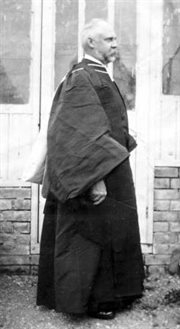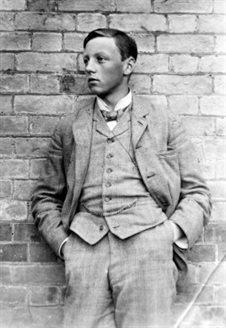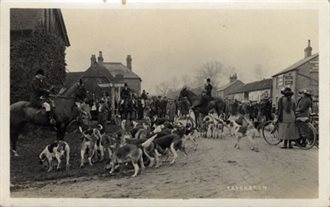Sunderland Family
This page was compiled by Trevor Stewart
The Sunderlands were an important family in and around the Halifax area. They were land owners of considerable wealth, had a large house known as Coley Hall and in history had been barristers and strong supporters of the royalists during the Civil War. They had later been heavily fined by Parliament for this involvement.
Thomas Lister Joseph Sunderland was born in Halifax in 1809. His father was Joseph Sunderland the Senior Surgeon of the Halifax Dispensary, and whose father Joseph had also been Surgeon there. His mother was Mary Lister, the daughter of one of Joseph’s junior surgeons in Halifax. Thomas had one brother, Langdale Marsden. Both boys were educated at Heath, (York), Shrewsbury and privately before both being admitted to Gonville and Caius College in Cambridge.
Thomas went up to Cambridge in December 1825 aged 17 and graduated with a B.A. in 1830 and an M.A. in 1833. He was ordained a Deacon in the Church of England at Lincoln in 1831 and priested in June 1832. He was immediately appointed as Vicar of Tilsworth (near Leighton Buzzard), but lived in Totternhoe Vicarage.
Langdale was admitted in October 1834 aged 20 and returned to Halifax three years later, possibly without graduating. He died unmarried in Fylde in 1846.
In May 1837 Rev. Thomas married Anne, the daughter of Thomas Lane Wood of Leighton Buzzard. They appear to have had at least eight children; those known are Thomas Joseph Sunderland (born Totternhoe 1838), Eliza Ann (born Totternhoe 1839 died aged 9 years 10 months), Marsden Samuel James (born Totternhoe 1841), Mary Ann (born Ravensden 1845), James (born Ravensden 1847), Langdale (born Ravensden 1850 died aged just 15 weeks), Sarah Martha (born Ravensden 1855) and Lister (born Ravensden 1858). There is also an Anne Wood Maria Sunderland whose date of birth has not been found but whose marriage in 1869 as an adult, is recorded in the Ravensden Church Registers.
Marsden Samuel James became a distinguished soldier, Commanding Officer of the Norfolk and Royal Sussex Regiments and was awarded the D.S.O. He fought with another famous Bedfordian, Colonel Fred Burnaby, at the Battle of Abu Klea in January 1885. Marsden died in Monmouth on 6th December 1929 aged 88 years, he had a daughter Mary who is buried with him but no record of any marriage has been found and there is no mention of a wife on the memorial.
Mary Ann married Harry Dove a Surgeon of Stowmarket at Ravensden in September 1877, but she was widowed by 1881 and back living with her mother and elder brother.

Reverend James Sunderland [Z1528]
James went up to Emmanuel College Cambridge in July 1869 and graduated in 1873. He became Curate and then Vicar of Eggington in 1881, where he remained in post until 1932. He married Florence Margaret Elton of Bedford in February 1874. (Florence’s sister Emma wed Charles Halliley and they later became the Grandparents of the actor John Le Mesurier). James had seven children including two sons who joined the army and had distinguished military careers.

Alfred Sunderland c.1893 [Z1528]
One (Lt. Colonel Alfred Joseph Sunderland), was killed at Railway Wood, Ypres, Belgium in July 1917, having already been involved in many recorded and documented acts of gallantry; the other, Major Brian Gresley Sunderland, Royal Artillery, died in 1971. Rev James himself died at Eggington in March 1932. During his time as Vicar he presented a magnificent stained glass window to the church in memory of his father Rev. Thomas L.J. Sunderland, ‘’one time Vicar of Tilsworth.’’
Sarah Martha married a Mr. Charles Hudson a merchant of Doncaster at Ravensden in June 1874.
Anne Wood Maria married Ardley Barnes, at Ravensden in April 1869. He was a Captain in the Royal Marines, and also had a very distinguished military career, especially during the China campaigns. He progressed through the ranks to become General of the Royal Marines Light Infantry. He retired in 1902 and died in February of that year.
Lister joined the Seaforth Highlanders (72nd Infantry Regiment) and died at Lucknow in May 1881 aged just 23.
When Rev. Thomas resigned the living at Tilsworth in 1845 he purchased the original house, (that which at one time had been owned by the Gostwicks, the Duchess of Marlborough and then the Duke of Bedford), known as the Grange in Ravensden. He began farming on a large scale taking over other lands close to the Grange when they became available and thereby extending his estates.
This building was set back behind Great Wood and Little Wood on the north side of the Bedford to Kimbolton road (now the B660) and one of the access routes was originally by way of the Green Lane and footpaths from Ravensden Church End to the Kimbolton Road. No doubt the expense of maintaining this ancient house and constantly making good the approaches caused the Rev Thomas and his wife to abandon the property and in 1854 build a new house beside the now surfaced Kimbolton Road with direct access onto the road. Perhaps much of the saved material from the old house was used in the construction of the new which was then to be known as Lower Grange Farm, later simply The Grange.

Lower Grange Farm c.1895 [Z1528]
The Rev. Thomas Sunderland died in 1857 at the age of just 49 but his wife Anne was to outlive him by a further 30 years. By the time of his death the family owned lands extended to the north side of Church End including Top Farm, and the western boundary was Ravensden Brook and the lands held as part of the Ravensden House estate by the Wythes family.
Despite their ownership of the traditional manor of Ravensden the Sunderlands were never regarded as the Squires of the village, an honour which appears to have fallen to the Wythes family. This seems to have been the cause of constant difficulty between the two families especially in connection with the wardenship of the church and the management of the school, a situation which became even more strained after Lt. Colonel Thomas Joseph Sunderland had inherited.
After the loss of her husband Mrs. Sunderland continued to administer the estate with kindness and benevolence looking after her servants and farm staff well. When Mrs. Sunderland herself died in 1887 the estate passed to her elder son Lieutenant Colonel Thomas Joseph Sunderland of the Bedfordshire Militia and Bedfordshire Regiment.
Thomas Joseph, born at Totternhoe, had moved to Ravensden with the family. He served with the Bedfordshire Militia (part time soldiers) and then the Bedfordshire Regiment eventually achieving the rank of Lieutenant Colonel. The 3rd Battalion of the Regiment was a home based battalion and no record has been found of Sunderland serving overseas. He became a Justice of the Peace and was High Sheriff of Bedfordshire in 1892.
In July 1873 in Yorkshire, Thomas Joseph married Annie Ripley a daughter of Sir Henry Ripley industrialist, founder of the Yorkshire Penny Bank, philanthropist and Liberal M.P. Ripley was a wealthy man who eventually moved to a very large estate in Shropshire. This marriage does appear to have been a rather unusual one in that although the couple had one son, they do not appear ever to have lived together and there is no trace of Annie being with Thomas on any Census either in Ravensden or elsewhere. His home is always managed by a housekeeper. Instead it seems that Annie and her son settled with her sister Phoebe and brother in law Charles Seton, in Herefordshire, rather than with her own husband. She died in November 1913.
Thomas had almost certainly been assisting with the management of the business before his mother’s death but he was a somewhat autocratic character and was always regarded with some misgivings. He applied a military discipline to everyone connected with the estate.
He was less generous than his mother, a feisty person who was content to turn out staff from the tied cottages when they were no longer able to work or their services were not required. There is even a story of a family being evicted when the father, a member of the farm staff, did his duty by joining up at the outbreak of the First World War and was therefore no longer available to work on the farm
In 1886 Sunderland purloined the village green, a triangular portion of grass with a pond which was situated at Church End at the exit of the Green Lane, and on which he built a police house known as Copper Cottage, but in so doing he deprived the villagers of common rights of grazing and communal use.
In November 1916 during the First World War and when the Herefordshire Regiment were under canvas and training on land close to his own, Colonel Sunderland was summoned for assaulting Private Arthur Horne of the Regiment and for shooting the regimental mascot, a much loved little terrier dog. Sunderland said that Horne was out exercising the dog when he allowed it to chase across Sunderland’s land after rabbits. He said that he asked Horne to retrieve the dog and to in future stay on the land that had been acquisitioned by the army. Horne refused (said the defence) arguing that he was on land on which he was permitted. An altercation followed when Horne alleged that the Colonel had pushed him to the ground, the dog ran off and Sunderland simply took his gun and shot it without further explanation. Sunderland was found guilty and was fined for both offences.
Later in the war he was fined £100 for feeding wheat and corn to the pigeons in his dovecote, even though these birds were themselves destined to become an alternative source of food during the scarcities. A further brush with authority was to occur in 1918 when Sunderland, along with many other land owners, objected to the ‘Order To Plough Parkland and Pasture’, issued by the War Office and the Ministry of Agriculture in order to grow much needed crops and vegetables on every available space, including the previously uncultivated parkland around large country houses
Despite his unfortunate character he did have a few good points. He became a Church Warden He paid his men to keep the churchyard in good order supplying gravel for the paths and using his carts to fetch coke from the railway sidings for the coke stove heating. His own stables were maintained in an impeccable fashion and every one of his twenty four working horses had a stable with their name above the door. His horses were the only creatures that were ever allowed to get anything over him!
He showed his concern for the lack of employment opportunities in the village by devising ways of giving men work during the slack winter months. He had small plantations of white thorn set out on a sloping field which could be seen from Kimbolton Road. These were supposed to represent the battalions as they were deployed at the Battle of Waterloo, but also provided welcome shelter for sheep, cattle and horses.
Conservation of water and drainage on the heavy clay lands were problems that he attempted to resolve by ordering the digging of a chain of ponds across the fields and constructing a reservoir beside the main road to serve the needs of the farm, and the house. He had cottages for employees built, together with a new dovecote. The village carpenter and coffin maker was always allowed to cut the timber he needed from the Sunderland owned woods.
Colonel Sunderland died in 1922 at the age of 83 and was succeeded by his only son Marmaduke Brian who survived his father by just eight years before he himself passed away in 1930.
Marmaduke Brian Sunderland was born in London in 1881. He referred to himself as a ‘’gentleman’’ and appears to have mainly lived with his mother in London and Herefordshire, but with visits of various durations to his father. He married Ruth Seton, the daughter of Colonel Bruce Seton of the Royal Engineers, in Marylebone in February 1905. Interestingly, despite their strange marital situation, both his mother and father were witnesses at the wedding. The couple had two daughters but as they had all lived in Wales for many years they had little interest in Ravensden and after the estates and property were tenanted for some years they were eventually sold in 1959.

Hunt meet at Ravensden crossroads, taken from Sunderland Hill c.1910 [Z1306/93/1/2]
The new houses on the west side of Church End were built where Top Farm used to stand and the other fields are generally now part of the Grange Farm estate. An interesting continued historical connection with the village though is the use of the name Sunderland Hill to describe the hill on the northern side of Ravensden Cross Roads on the B660, where the road passes the Grange, Grange Farm and the cottages. ‘Sunderland Hill’ is still part of the full postal address for these properties.